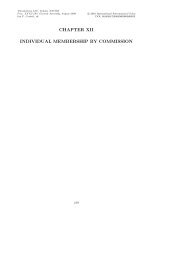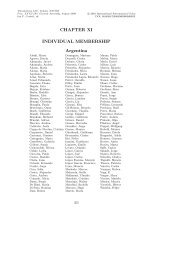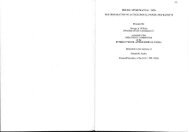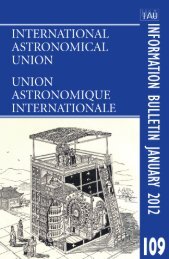IAU - INFORMATION BULLETIN No 84
IAU - INFORMATION BULLETIN No 84
IAU - INFORMATION BULLETIN No 84
- TAGS
- bulletin
- www.iau.org
You also want an ePaper? Increase the reach of your titles
YUMPU automatically turns print PDFs into web optimized ePapers that Google loves.
<strong>IAU</strong> / <strong>INFORMATION</strong> <strong>BULLETIN</strong> <strong>No</strong> <strong>84</strong> file:///Users/luis/Desktop/IB/IB<strong>84</strong>.html<br />
SWAS launched<br />
NASA' Submillimeter Wave Astronomy Satellite (SWAS), a Small Explorer Mission of two year<br />
duration, to investigate the composition of dense interstellar clouds, has been successfully<br />
launched on December 5, 1998 with PEGASUS from VDBAFB. Further information can be found<br />
at: http://sunland.gsfc.nasa.gov/smex/swas/<br />
Mars Climate Orbiter launched<br />
NASA's Mars Climate Orbiter (MCO) is part of Mars Surveyor 98 program and has been<br />
launched on December 11, 1998. (DELTA II Launch; Cape Canaveral). Further information can<br />
be found at: http://mpfwww.jpl.nasa.gov/msp98/msp2.html<br />
Mars Polar Lander launched<br />
NASA's Mars Polar Lander is part of Mars Surveyor 98 program and has been launched on<br />
January 3, 1999. (DELTA II Launch; Cape Canaveral ). This Mission carries the DEEP SPACE 2<br />
Mars Microprobes. Further information can be found at: http://mpfwww.jpl.nasa.gov/msp98<br />
/msp2.html<br />
WIRE failed after launch<br />
NASA's Wide Field Infrared Explorer (WIRE) has been launched on March 4, 1999, with Pegasus<br />
from Vandenberg AFB. A too early opening of the cover of the telescope caused the loss of the<br />
Hydrogen needed to cool the telescope and instruments as announced on March 8, 1999. WIRE<br />
had been expected to make a survey of the IR sky to detect starburst activity for the duration of its<br />
Hydrogen coolant (at least 4 months).<br />
Commission 6<br />
Annual Report of the Central Bureau for Astronomical Telegrams, 1998<br />
The rate of publication of the <strong>IAU</strong> Circulars continues to increase, the 278 issued in 1998 - five<br />
more than in 1997 - representing another record. As in other recent years, the main reason for the<br />
increase has been the great number of discoveries of supernovae and comets. Some 56 percent of<br />
the Circulars issued contained items on supernovae, while 47 percent contained items on comets.<br />
In addition to the 158 supernovae reported in 1998 data during the year, there were also reports of<br />
29 supernovae from images obtained in 1997 and earlier. Fully one-quarter of the supernovae<br />
were fainter than mag 22.5 at discovery, with two of them recorded at mag 26.8. Three supernovae<br />
- 1998S in NGC 3877, 1998aq in NGC 3982 and 1998bu in NGC 3368 - attained mag 12 visually,<br />
and the first of these was the single most popular topic during the year, with observations of it<br />
reported on 19 different Circulars.<br />
As for comets, even excluding the five predicted recoveries of periodic comets and the five belated<br />
discoveries from images obtained in 1997, the remaining 46 handsomely broke the previous<br />
annual record. The five belated discoveries were obtained with the LASCO white-light<br />
coronographs aboard the Solar and Heliospheric Observatory (SOHO) spacecraft, and SOHO<br />
was responsible for 16 additional comets found before the temporary failure of the mission in<br />
8 of 37 5/19/08 10:03 AM






